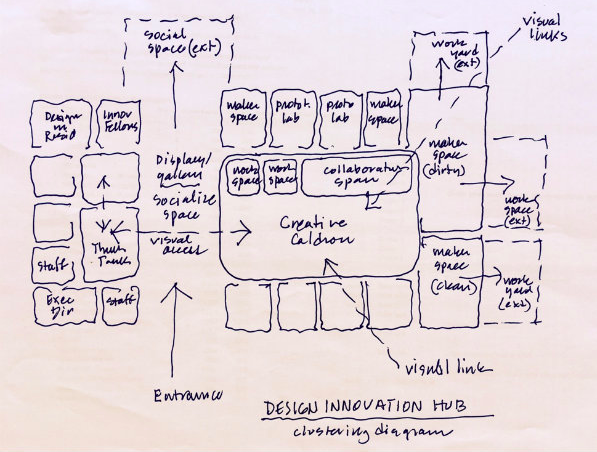Design Innovation Hub pushes toward increased campus sustainability

The Design Innovation Hub’s expected layout. Photo provided by J.R. Campbell.
February 7, 2020
Intellects, designers and creators will soon have an energy-efficient environment to gather and share resources and expand their knowledge. The Design Innovation Hub (DI Hub) is under construction and scheduled to be ready for use by the fall 2020 semester.
The DI Hub is a building where students from different areas of study can operate as a team in the same area. J.R. Campbell, the executive director of the Design Innovation Initiative, explained that the goal of this space is to create an environment for students to participate in cross-disciplinary collaborative problem-solving.
While construction continues on the building, attention has been focused on much more than just the intellectual benefits and academic motives. The DI Hub is also scheduled to become LEED-certified upon completion.
LEED certification is conducted through the U.S Green Building Council. The acronyms of LEED stand for Leadership in Energy and Environmental Design.
“This is a certification process for buildings that minimize their impact on the environment,” said Michael Bruder, the executive director of facilities planning and operations. Bruder explained that this will be done through the use of multiple energy-efficient systems.
“Kent State’s sustainability projects have reduced energy consumption at the Kent campus by 24 percent,” said Kent State Sustainability Manager Melanie Knowles. She explained that Kent State has become increasingly environmentally friendly through multiple different channels including transportation, recycling and reusable resources.
Sustainability projects are determined based on three deciding factors. Profit (prosperity), people and place. If the project benefits the environment surrounding it — the people — and is financially sound, it is considered to be a sustainable option.
The DI Hub’s dining facility will also contribute to the success of a greener campus. “We’ve been looking for years about how to address food waste on our campus,” said Knowles.
A food containing system called Grind2Energy will be built into the dining facility. This structure will grind up and store compressed food scraps in a tank. The tank will then be transported to a local Emerson chain, an energy management company, that turns the food waste into renewable energy. This will be one of many ways the building achieves LEED certification.
Becoming certified is determined based on a point system. The LEED project checklist is out of eight categories and 110 possible points. “The greater the energy efficiency, the more points you get,” said Knowles. The construction of the DI Hub is set to fulfill all major requirements to receive its certification.
Theresa Lovrak covers construction and downtown. Contact her at [email protected].
















